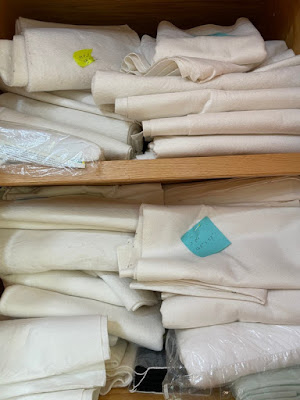You've heard the old adage before: "Use it up, wear it out, make it do or do without". Well, that's what I'm doing, with my batting strips. I buy batting on 30 yd. rolls, the width is either 93" or 122" depending on if it's a queen or king-size roll. When I cut batting for specific quilts I am usually left with ample sized strips remaining, they're never discarded; the proof is shown in the photo here. I have an upper cupboard in the sewing room
FULL of these batting scraps, all labeled with their dimensions. Well, as we know, there has been a batting shortage with incredible delays in shipping thanks to COVID and the cotton going first to the manufacturing of PPE. So, it stands to reason, that if I don't "make do" with what I have on hand I may very well be "doing without" (
or at least waiting for a good long time!) when it comes to batting. I had tried using the fusible tape for joining batting in the past but really didn't care for it at all; it left a stiff strip at the join that was detectable to me even after the quilt was sandwiched and quilted. I wasn't happy with that. I decided to try another method.

I made a clean cut along the two edges to be joined together and lined them up exactly next to each other, being careful not to overlap them but gently pushing them to meet in the middle. I put on my walking foot and set my machine to a
stitched zig zag (#16 on my Bernina) sometimes used as a mending stitch.

I didn't pin anything but carefully helped to guide the two edges together by resting my hands on either side, I let the machine do all the work; I didn't push or pull on the batting at all, simply guided it smoothly under the foot.
Here's what to join looks like, it is smooth and completely undetectable inside the quilt sandwich. I don't use any of these cobbled-together battings on customer quilts or on any other than those for myself. And, naturally, I only join together identical batting weights; I typically only use Quilter's Dream Blend so that's not a problem for me. If you use a variety it would be helpful to label your batting strips and scraps with the brand and loft weight along with the measurements, that will save you time and energy in the long run when you're rummaging through your own leftovers.
Undoubtedly there are many ways of accomplishing this frugal task
with the same result, this is simply a method that works well for me!
What do you have that you're USING UP or MAKING DO with?
Life is Good!















8 comments:
I make Frankenbatting from my leftovers or use them inside the long long runners I make for my sister (or other utility mats). Waste not, want not!
I’ve always saved batting scraps although I don’t label them (lazy!). My favorite joining stitch is a 3-step zigzag stitch on my Husqvarna machine. There is almost some batting cutoffs waiting to be joined :)
This is what I do too. I have found these work well in donation quilts.
I do this all the time. I have a Bernina and use the 10D foot. It is and edge stitch foot. The battings butt up against the flange. No need to pin. Fast and easy and you can not tell the batting has been pieced once the quilt is quilted.
Such a great way to use up those little pieces of batting (and a great way to save some money). Batting can be expensive! Thanks for the inspiration.
If I was joining, I use the method you have shown, but often I use those remaining pieces for my own or charity quilt and don't even sew them, I just lay them on the backing that has been loaded on the longarm, (held with some pins at each end) butt the edges together and lay the top over and quilt it. The quilting stitches hold it all together and noone would ever know after the binding goes on!
I've been doing this exact same stitch-together batting for years. And save all the smaller pieces for place mats, mug rugs, pot holders, etc. Waste not ...
What a great way to use up batting strips. I think an important point in your process is to "label with dimensions!" I'll have to remember that the next time I have left-over batting.
Post a Comment